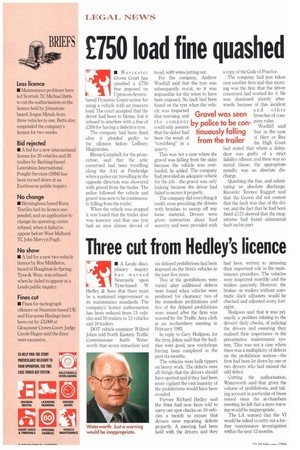Three cut from Hedley's licence
Page 10

If you've noticed an error in this article please click here to report it so we can fix it.
• A Leeds disciplinary inquiry has warned Newcastle upon Tyne-based W Hedley & Sons that there must be a sustained improvement in its maintenance standards. The company's licence authorisation has been reduced from 15 vehicles and 10 trailers to 12 vehicles and 10 trailers.
DOT vehicle examiner Wilfred Johns told North Eastern Traffic Commissioner Keith Waterworth that seven immediate and six delayed prohibitions had been imposed on the firm's vehicles in the past five years.
Two of the prohibitions were varied after additional defects were found when vehicles were produced for clearance: two of the immediate prohibitions and five of the delayed prohibitions were issued after the firm was warned by the Traffic Area clerk at an in-chambers meeting in February 1993.
In reply to Gary Hodgson, for the firm, Johns said that the facilities were good, new workshops having been completed in the past six months.
The vehicles were bulk tippers on heavy work. The defects were all things that the drivers should have spotted and if they had been more vigilant the vast majority of the prohibitions would have been avoided.
Partner Richard Hedley said the fitter had now been told to carry out spot checks on 10 vehicles a month to ensure that drivers were reporting defects properly. A meeting had been held with the drivers and they had been written to stressing their important role in the maintenance procedure. The vehicles were inspected monthly and the trailers quarterly. However, the brakes on trailers without automatic slack adjusters would be checked and adjusted every fortnight.
Hodgson said that it was primarily a problem relating to the drivers daily checks, of policing the drivers and ensuring they realised their importance in the preventative maintenance system. This was not a case where there was a multiplicity of defects on the prohibition notices—the firm had been let down by one or two drivers who had missed the odd defect.
Cutting the authorisation, Waterworth said that given the volume of prohibitions, and taking account in particular of those issued since the in-chambers meeting, he felt that a mere warning would be inappropriate.
The LA warned that the VI would be asked to carry out a further maintenance investigation within the next 12 months.




































































































